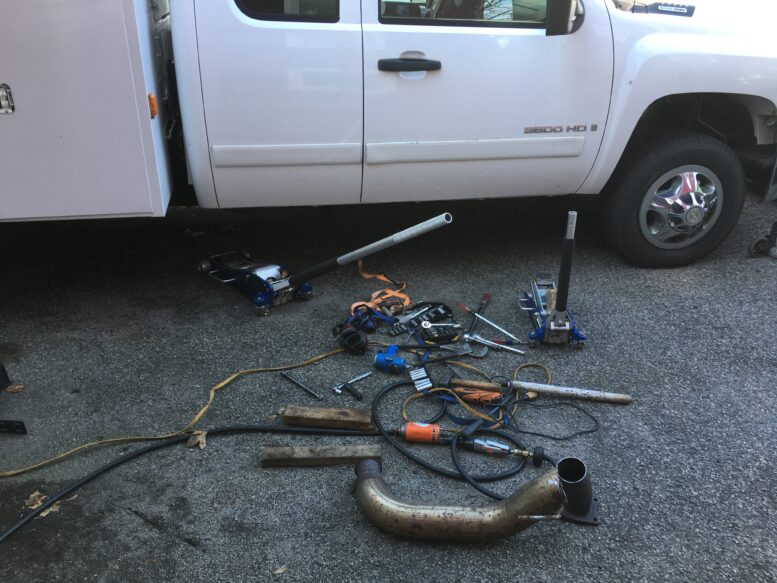Last week I wrote about the surprise of finding that the catalytic converter in my truck—the formerly mouse-infested 2008 Chevy 3500HD Duramax diesel that I wound up with because my former engineering job accepted a ridiculously low offer I made for it after they largely abandoned it when they closed my old building—had been stolen, Sawzalled out in the kind of theft that has reached epidemic proportions even in a safe city like Newton. I examined my options for replacement, but could not find a compatible used cat, and ordered the only click-and-buy recertified cat I could find.
While I waited for it to arrive, I removed the remaining sections of the old cat assembly. The front section is attached to a pipe that comes down from the engine, held in place by a single heavy-duty band clamp that squeezes the two sections together. I had it out in a minute.
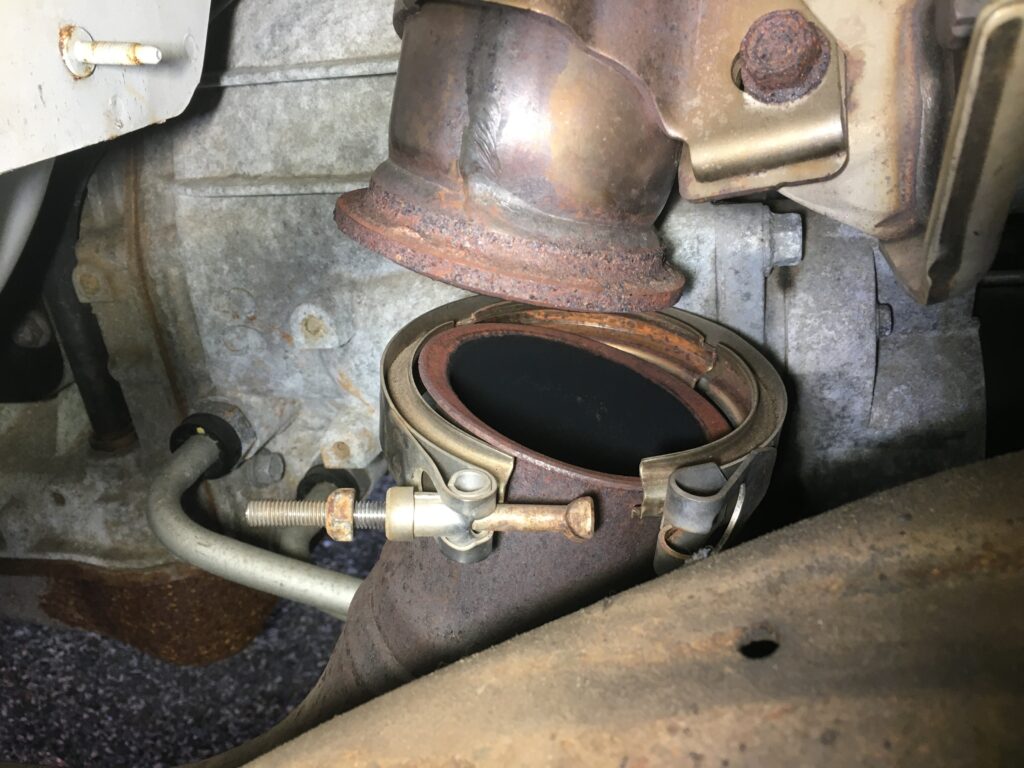
I’d never seen an arrangement like the front cat pipe attachment, but it disconnected easily.
The rear section is attached to the diesel-particulate filter (DPF) with nuts on four big studs. As soon as I looked at those, it triggered a thirteen-year-old memory of pulling the exhaust on my ’99 Z3 M coupe to replace the clutch, and breaking four of the six studs that held the center resonator to the exhaust manifolds. That was the event that caused me to buy an oxyacetylene torch to remove the snapped-off portions.
It was such a pain in the butt that ever since, I’ve been very careful removing fasteners that will put you in a world of hurt if they break. So I heated the nuts on the truck’s rear flange with a MAPP gas torch and applied wax to the threads. When the nuts didn’t budge with the impact wrench, I heated and waxed them again. Three of them came off, but one broke, which caused me to pull out the oxyacetylene torch to do the “can’t be tight if it’s liquid” thing (well, not liquid—more like Play-Doh) and heat the snapped portion to get it soft enough to punch out. For a host of reasons, it took most of the day, and certainly added to my dislike of what I thought would be a simple repair.
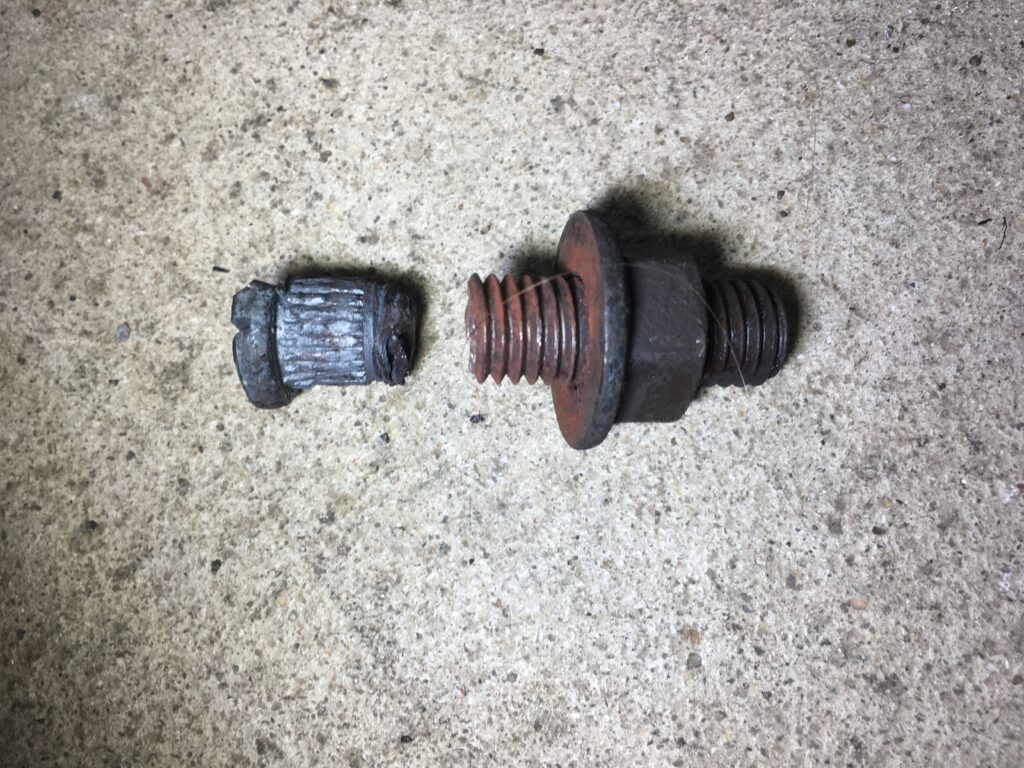
This little bugger ruined my day.
The cat assembly arrived late Thursday afternoon. With these short winter days, I figured that I had about an hour and twenty minutes of sun remaining—but hey, with just a four-bolt flange in the back and a single clamp in the front, it should be quick, right?
Oh, boy, was I wrong.
The first thing I found was that the two sawed-off pieces had been easy to remove (the snapped-off stud notwithstanding) because they were small enough to maneuver out of the truck. In contrast, the whole cat assembly is four feet long, and there was no way to stuff it in place without removing the transmission cross-brace.

The cut pieces were easily removed. Installing the replacement assembly was far more challenging.
If you’re like me, the term transmission cross-brace conjures up the piece that holds up the back of a 2002 transmission—a thin piece of stamped metal less than a foot long. It’s downright cute. The one on the truck, however, is neither small nor cute; it’s a huge brace that extends the width of the truck and holds up the massive six-speed Allison transmission and the transfer case that’s attached to it.
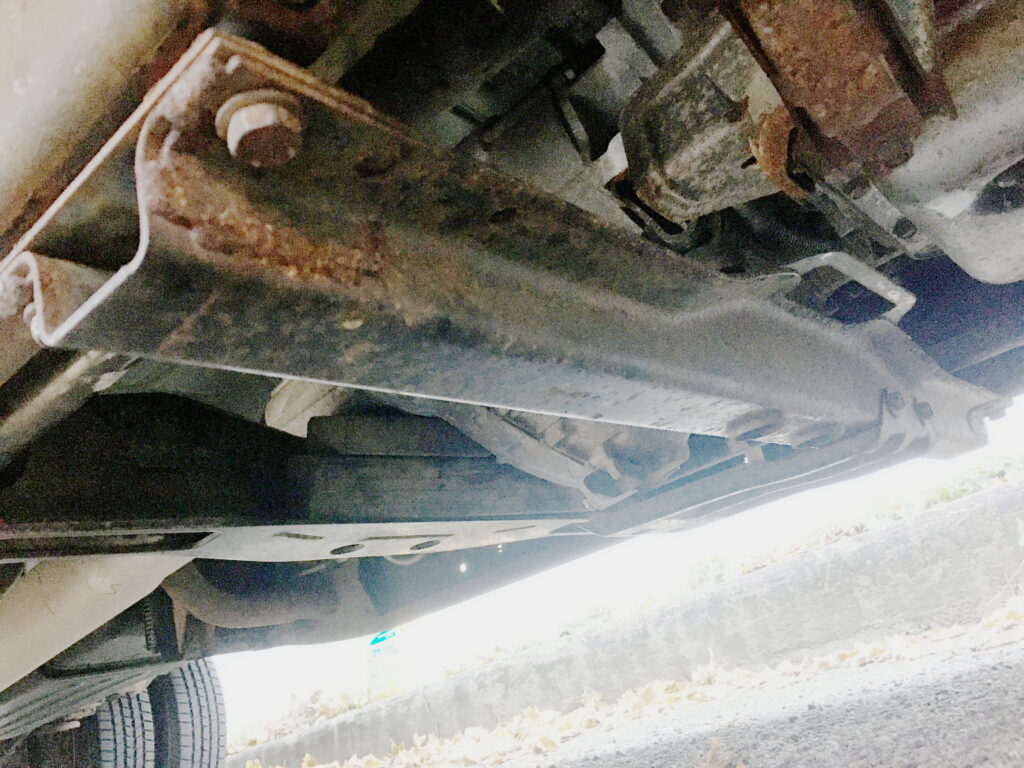
The truck’s transmission-support bracket had to be removed to get the cat assembly in.
I woke up the next day and attacked it. Despite the intimidating size of both the brace and the transmission, it wasn’t bad. I supported the transmission with a big floor jack, put some wood under the back of the transfer case where it passed over another brace, battled the corrosion on the bolts, and lowered the brace so I could slip the cat past it.
And that’s when the surprise came.
I’ve hung dozens of exhausts over the years. I never thought about it, but they all shared the characteristic that they were self-supporting. That is, there have always been flanges with bolt holes at both the front and the rear. Whether you slide the flange over studs and spin the nuts on them, or you have to pass bolts through the holes in a mating flange first, once you do that, the exhaust supports itself, allowing you to tighten the nuts round-robin (which pulls the flanges toward each other) and tweak any alignment issues.
In stark contrast, the front attachment of this cat assembly—the heavy-duty band clamp that was so trivial to remove—proved to be an absolute nightmare for reinstallation. In the photo below, you can see that the front of the cat pipe is flared, and mates against a pipe that comes down from the engine and has a rounded face—but there’s no flange that you can pass a bolt through and spin on the nut to hold it in place. Plus, there’s no gasket or crush ring, so the alignment between the two has to be nearly perfect for the band clamp to hold and seal them.
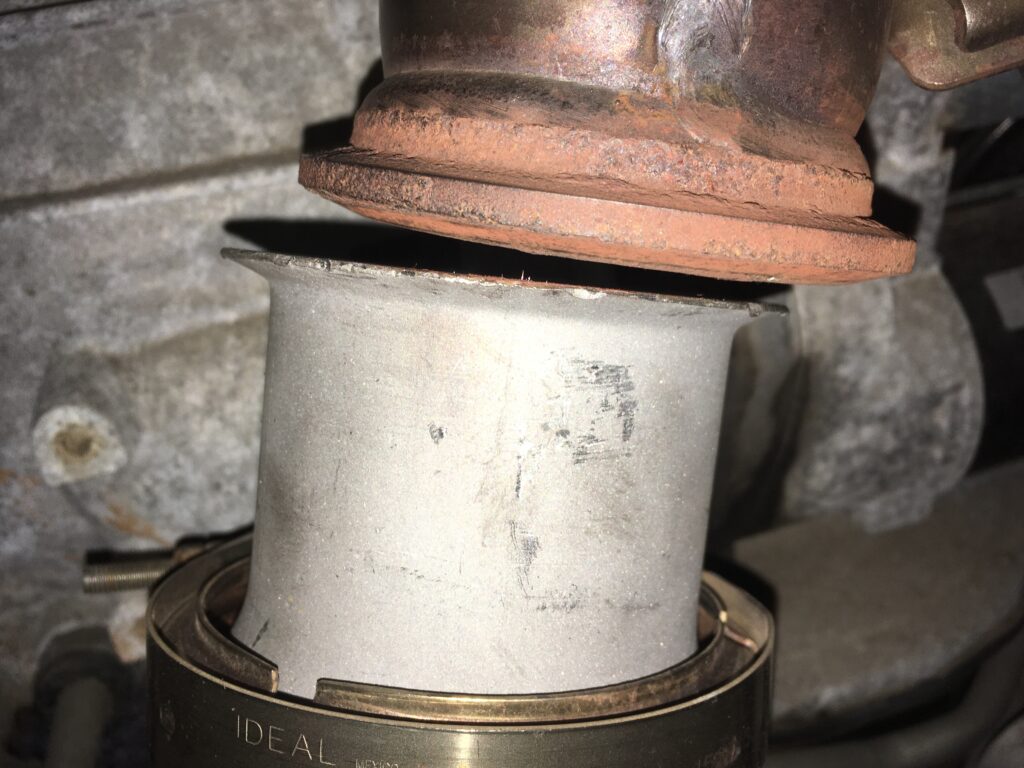
Damn you to hell, non-self-supporting front cat assembly attachment point!
So what I thought would be a 30-minute job took all day, while I threw everything I had at it. The flange on the back of the cat assembly went on the studs coming out of the front of the DPF (and I didn’t tighten the nuts on the studs, thereby allowing adjustment), but I had to try to balance the front part of the cat assembly on a floor jack to get it in the neighborhood of the pipe coming down from the engine. To try and align the two mating surfaces, I had three ratchet straps installed to pull the exhaust in various directions; I felt like I was trying to dock the Space Shuttle. And even with all this, it seemed that no matter what I did, the front of the cat pipe was twisted relative to the engine pipe; I could not get them aligned well enough to get the clamp on them.
To make matters worse, the weather forecast was for 30-degree weather to move in over the weekend, with snow possible on Sunday. With this cat replacement achingly close to completion, I wanted it buttoned up now.
Finally I found that the core of the problem was that a rubber exhaust hanger had fallen off the muffler at the very back, causing the entire fifteen-foot-long exhaust to twist. I temporarily replaced the hanger with a hose clamp, which had the benefit of allowing me to carefully adjust the amount of rotation. With that, I got the two front mating surfaces close enough to get the clamp on them.
As I said, this setup is designed to seal two perfectly-mated pipes, not to pull two mis-mated pipes toward each other, but it was so close that I went for it and tightened the clamp. The realist in me thought that it was likely that it would leak, and I’d have to pay someone with a real garage to re-hang the thing, but to my delight, when I started the truck and passed my hand around the flange, I felt no leakage.
Whew!
This was the most automotive work my beat-up 64-year-old body had done since I messed up my back in August. I crawled out from under the truck feeling like the damned thing had run me over: sore back, stiff neck, in need of ice, Advil, and rest.
It made me think.
I’ve spent decades writing about wrenching on cars—analyzing a problem, the joy that comes from solving it your way, and saving money while doing so. Most of the work I do is either on the vintage cars (the BMWs and the Lotus Europa) that I love, or on the daily-driver BMW (currently the E39 2003 530i stick sport) that I really like. The vintage cars are simple, and the work can occur at whatever pace seems natural.
The daily driver is different because it’s complex, its role is such that it needs to be kept running, and working on it is far less Zen-like; it’s more an exercise in driving something that I wouldn’t be able to afford if I had to pay someone to keep up with the maintenance issues.
In other words, I like the result more than the process.
The work I do on the little Winnebago Rialta RV is similar; it’s a pain to work on, but I like the payoff of having the RV to go to the beach with my wife. In contrast, with this cat replacement, I enjoyed neither the process nor the result. There was nothing joyous about spending $800 and nearly two days because some low-life chopped the cat out of my truck, a vehicle that I don’t even really like or use all that much.
Yes, when I was done, I was glad that I had the truck back; I mean, you never know when some must-show-up-with-a-truck-and-trailer vehicle will appear on Facebook Marketplace. But so far, that’s been much more of a hypothetical than an actual benefit.
As for ensuring that it doesn’t happen again, the skinny on the web is that basically, you can’t. There are three basic approaches: a cage around the catalytic converter, a plate blocking access to it, and an alarm system that senses the vibration of the Sawzall. The online price for a cage for a truck with four-inch exhaust pipes is eight hundred dollars, and I can’t find a bolt-on shield kit for this particular truck. Besides, cages and plates can be cut through just like the cat pipes, and the alarm just becomes one more alarm everyone swears at and then ignores when it goes off in the night.
Still, when my vertebrae have the fortitude to crawl back under the truck, I’ll look at how hard a plate would be to fabricate and install, and it’s difficult to see the harm of a $30 alarm. But hey: I got out of the stolen-cat episode for $800 and two days of wrenching. I guess I’m still going to call this one a win.
As long as I soon use the truck to tow home something that I’ll actually enjoy working on.—Rob Siegel
____________________________________
Rob’s newest book, The Best of The Hack Mechanic, is available here on Amazon, as are his seven other books. Signed copies can be ordered directly from Rob here.

